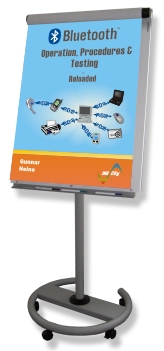 Bluetooth -
Bluetooth -
Operation, Procedures & Testing - Reloaded
[2-day course, Euro 2,350.- (net) per participant]

Bluetooth and its Environment
History and Evolution of Bluetooth
Important Milestones
Key Features within the various Releases
Bluetooth Rel. 1.0B / 1.1, Bluetooth Rel. 1.2 / AFH / eSCO, Bluetooth Rel. 2.0 / EDR, Bluetooth Rel. 2.1 / SSP, Bluetooth Rel. 3.0 / AMP, Bluetooth Rel. 4.0 / BLE, Bluetooth Rel 4.1 / IoT
Typical Applications
Legacy Bluetooth
Ad-hoc Networking and Cable Replacement, Low Price (USD 5.00)
Bluetooth Low Energy (BLE)
General Ideas behind BLE, Smart and Smart Ready Logos, Envisaged Application Domains, Synergy with Energy Harvesting
Administrative and Organizational Background
The Special Interest Group (SIG)
Promoter Members, Associate Members, Adopter Members, Individual Members
The Bluetooth Qualification Program
BQRB, BQA, BQB, BQTF, BTA and BTAB, The Qualification Process
Testcase Categories
Technical Concepts
Architecture and Architecture Options (BR / EDR)
Piconet, Scatternet
Architecture and Architecture Options (BLE)
Operation – User Perspective
Bluetooth Main Menu in a Smart Phone
Device Discovery and Pairing
Secure Simple Pairing
Supported Applications
Technology at a Glance
The Physical Resource
ISM-Frequencies in different Countries
Time / Frequency Grid as defined for Bluetooth BR/EDR
Definition of the Physical Channel, Multi-Slot Packets
Time / Frequency Grid as defined for Bluetooth Low Energy
Advertising Events, Connection Events
At the very Bottomline of Bluetooth: The Access Code
Introduction
Distinction of concurrent Piconets
Types of Access Codes
GIAC (General Inquiry Access Code), DIAC (Dedicated Inquiry Access Code), DAC (Device Access Code), CAC (Channel Access Code)
Generating the Access Code
Bluetooth Addressing
Overview
BD_ADDR
Introduction, Tasks and Functions of the BD_ADDR, Authentication and Encryption, Hopping Sequence Calculation, Access Code Calculation, Initialization of Checksum Calculators
Example of BD_ADDR and Local Name
The Bluetooth Clock
Important Clock Outputs, Master – Slave Relationship
Power Classes
BR / EDR, Power Class 1, Power Class 2, Power Class 3, BLE
Protocol Stack (Overview)
Overview, Bluetooth Controller, Bluetooth Host
Lower Layers – the Bluetooth Controller
The Physical Layer
Modulation Schemes
GFSK, π/4-DQPSK, 8-DPSK
Forward Error Correction
1/3 Rate Encoding, 2/3 Rate Encoding
Data Whitening
Physical Channels in Bluetooth BR/EDR
Overview, Inquiry Scan Physical Channel and Inquiry Procedure, Page Scan Physical Channel and Page Procedure, Detailed Packet Flow of the Page Procedure, Basic and Adapted Piconet Physical Channels, Relationship between Slot No and Transmit Direction
Baseband Packet Types and Formats (BR/EDR)
General Format Rules (BR = GFSK)
General Format Rules (EDR)
Format of Baseband Control Packets
ID-Packet, NULL-Packet, POLL-Packet, FHS-Packet
Baseband Data Packets
Naming Conventions, Baseband Packet Type Table, Relationship between Packet Type and Logical Link, Packet Types on SCO and eSCO, Packet Types on ACL, Example of a Baseband Data Packet Format: DM1
Link Manager Operation
Introduction and Overview
Important Link Manager Procedures
Authentication and Encryption
Overview
Detailed Consideration of BLE Operation
State Machine
GAP-defined Roles: Observer, Broadcaster, Peripheral and Central
Baseband Packet Type and Format (BLE)
General Format
Format of Advertising Channel PDU's
Format of Data Channel PDU's
Upper Layers – the Bluetooth Host
Protocols on the Host
The Stack
Overview of Protocols, Port Numbers and PSM's
Host Controller Interface (HCI)
Overview and Transport Plane
Communication through the HCI
Packet Types, Format and Content of Command Packets, Format and Content of Event Packets, Format and Content of Data Packets (SCO/eSCO/ACL)
Typical Scenario: Connection Establishment and Release
Initial Messaging / Paging, Authentication, Connection Active, Disconnection
Logical Link Control & Adaptation Protocol (L2CAP)
Tasks and Functions
Interfaces the controller to the application, Provides logical channels, Segmentation and Reassembly, Error Control and Retransmission, QoS
Operation Modes
Connection-Less Operation, Basic L2CAP Mode, Flow Control Mode, Retransmission / enhanced Retransmission Mode, Streaming Mode
Channels and CID's
Protocol Service Multiplexers (PSM)
PDU-Formats in L2CAP
Basic L2CAP-Format (B-Frame), Connection-less L2CAP-Format (G-Frame), Retransmission and Streaming Mode Formats
SDP and ATT
Commonalities
Client Server Model in SDP and ATT
Introducing UUID's
Example 1: Service Class Names for SDP, Example 2: GATT-based Services, Example 3: GATT-based Service Characteristics
Example of a Service (Headset Service)
PDU-Format in SDP
Operation of SDP
Step 1: Operation on L2CAP Channel ID 0001, Step 2: Service Interrogation between Client and Server, Description, Step 3: Headset Service Setup based on SDP-Information, Description
PDU- and Attribute-Format in ATT
Attribute-Structure
Service Description in ATT
Generic Table View, Service Description Example
Bluetooth Profiles
General Information
Profile Stack for BR/EDR
Profile Stack for BLE
v4.1
Search:
More Info:
General Information about this course
Schedule of this training course
Buy this book
INACON eBooks
Please have a look at our full offer

